“Content is King” was Bill Gates’s famous essay in 1996. The article predicted that information on the internet would be huge as communication costs decrease. The result would be more companies participating in content creation and making money by supplying valuable knowledge. Today, with such diverse content available on the internet, predictions are more accurate than ever.
Businesses today increasingly use sales copies to promote their product or service through websites. With around 400 million people viewing over 20 billion web pages monthly, effective content marketing is now a critical strategy for every company. Learning how to write website copy that will increase conversions organically is essential.
However, against constantly evolving search engine algorithms, having your content stand out is a challenge. Google, for example, screens your website’s content for value. It assesses whether your copy provides relevant and high-quality information to users. But what qualifies as relevant and high-quality is challenging to understand.
Plus, with Artificial Intelligence (AI) entering the scene, copywriting requires greater subtlety and tact to craft attention-grabbing content.
So, below we explain 10 general steps that will help you improve the quality of your website copy. We also outline a few tips guiding you on how to write website copy using AI.
In This Article
- 10 Steps to Improve Your Website Copy
- 1. Highlight Solutions to Customer Problems
- 2. Use Language That the Customer Understands
- 3. Write in Line With Your Brand Values
- 4. Use Consistent Tone and Style
- 5. Write With User Intent in Mind
- 6. Use Reliable Statistics and Other External Resources
- 7. Define the Content Structure
- 8. Avoid Fluff
- 9. Avoid Keyword Stuffing
- 10. A/B Testing
- Using AI in Website Copywriting: 6 Tips to Make the Most Out of AI
- [Bonus] 3 AI Tools for Website Copywriting
- Conclusion
- FAQ
10 Steps to Improve Your Website Copy
Several steps would help you to improve your website copy and reach better results. Below is presented a checklist for a quick reference and each step is explained in more detail later on.
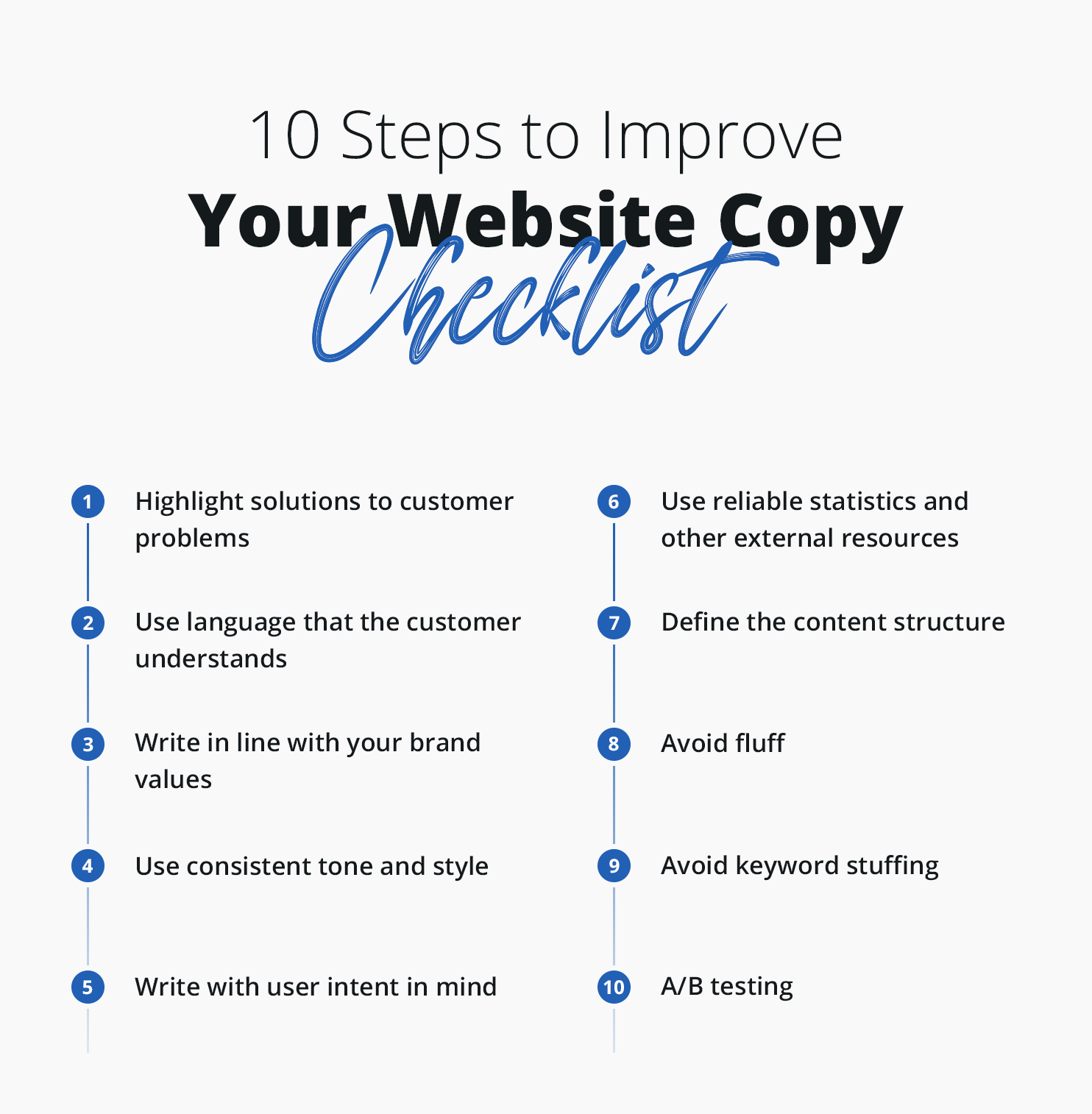
1. Highlight Solutions to Customer Problems
Businesses often write copy that only emphasizes the product’s or service’s features. Just highlighting the features doesn’t tell the customer how your business solves their problems. Remember, the customer is looking for value and trying to discover how your product or service can help. And this should be the guiding principle on how to write website copy.
Instead of listing all the features, you must explain how each solves a specific issue. Also, don’t go into many details and tailor your content to your target niche. For example, if you are selling an economical car, avoid giving details of all its features. Instead, focus on factors that make the car affordable, such as fuel efficiency, low up-front cost, easy maintenance, etc.
However, selling a vacuum would require highlighting a different feature set. For instance, you can highlight its cleaning efficiency, durability, low sound, etc. Customers who want a vacuum cleaner wish to solve a different problem than those who want to buy a car. For instance, people wanting a vacuum cleaner wish to clean up their houses quickly with minimal effort. As such, a sales copy describing a vacuum cleaner should highlight how its features enable them to do so.
2. Use Language That the Customer Understands
As simple as it sounds, the step can be challenging to accomplish. Using language customers can relate to involves understanding their pain points in detail. You can get such information by reading customer reviews and filtering out what they want in a specific product. Customer surveys are also a good source of such data. The research will help marketers decide how to write website copy, so it highlights solutions to specific pain points to increase customer engagement.
However, you must ensure that every page on your website reflects customer values. For example, your About page, landing page, pricing page, etc., should all have elements that address the customer’s common frustrations. For instance, all content on your website must highlight your pricing flexibility if customers expect versatile packages for specific needs.
If you are selling a website builder tool and customers want a solution that can efficiently cater to their requirements, you should highlight customizability features in your sales copy. Further, you can shape your About page to say that your company understands that every customer is different and there is no one size fits all.
Here is an example of Semrush’s About page.
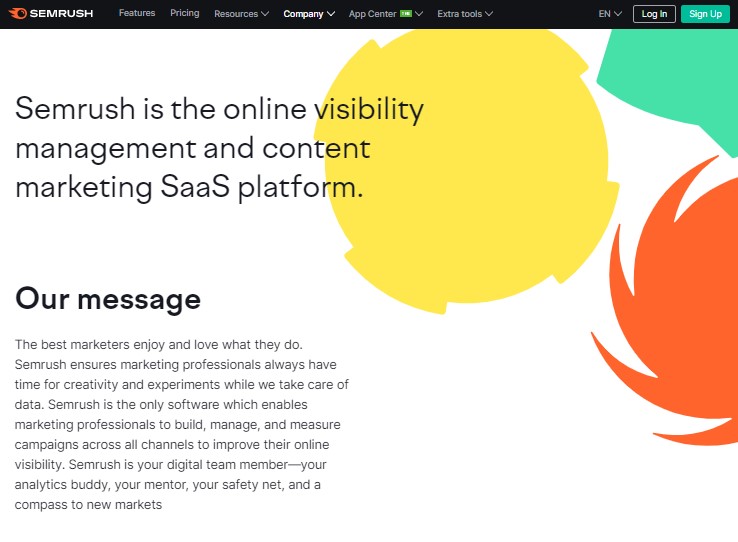
3. Write in Line With Your Brand Values
In today’s digital world, you must know how to write website copy so it acts as your business’s primary elevator pitch. But as you have specific values and culture behind your company, so do your customers. They want to buy from companies that resonate with their beliefs. For example, customers who care deeply about a business’s environmental footprint will want to build relationships with organizations with stringent standards to ensure their operations are environmentally friendly.
Apple is the quintessential example of brand values. With creativity, individuality, and passion for positive change, Apple attracts people who share these values and ensures brand loyalty. Similarly, you must clearly outline your brand values and write sales copy that aligns with your company’s attitudes and beliefs.
However, the real question is how to identify such values. Sometimes, the values come directly from the company’s founders. At other times, you must dig deeper to understand what your company should stand for. In particular, you must realize:
- how your customers want to see you,
- how they currently see you,
- how you want to position yourself in the market.
Again, customer reviews, surveys, and questionnaires can be vital sources of such information. But you must be careful when designing surveys and questionnaires as you may get misleading responses. You must phrase open-ended questions to ensure that you receive precise and coherent answers.
After gathering insights from the data you collect, you can clearly define your values and incorporate them in your sales copy with subtlety. For example, suppose you’re selling a web development tool, and one of your brand values concerns trust and accountability. In that case, you can state how your team builds a one-to-one relationship to support customers who stay with the brand continuously. You can also have direct contact information of sales representatives on your landing pages to improve trustworthiness.
4. Use Consistent Tone and Style
After establishing your brand value, you must focus on your content’s tone and style. The two elements go together, but they are pretty different.
Style is the way your write, while tone concerns how you sound.
For example, you can have a formal style when writing sales copy for business clients. But you can have a humorous tone to make the content more engaging. Yes, you can add humor when writing copy for business executives. However, it must be relevant and in the correct quantity.
Of course, your tone and style must align with your brand values. Suppose integrity is one of your brand values. In that case, your sales copy should emphasize it through original research, commitment to solving customer issues, and using actual reviews to show how your existing customers benefit from your product or service. You can write it formally with a strong, authoritative, and reassuring tone.
A comprehensive style guide can help achieve a consistent style across all your content. The style guide should be a critical component of your overall content strategy. It should highlight writing principles, color themes, image types, content length, structure, and other bells and whistles to ensure your sales copy reflects your brand values.
Customer personas can help create style guides. For example, if you’re selling games, a typical customer persona might be a tech-savvy teenager who likes adventure games. You can then develop an appropriate style appealing to such customers.
5. Write With User Intent in Mind
So once you know what your customers expect from your product and their pain points, know your brand values, and have a comprehensive style guide, you’re all set to write the perfect sales copy that will surely convert. But would it?
The steps above are just the tip of the iceberg. They’re the founding blocks for developing the skeleton of your sales copy. The real challenge lies in identifying the user’s intent. But what exactly is user intent? And how can user intent be a guide on how to write website copy? The questions have as many answers as the number of user groups potentially visiting your site.
What it means is that users visit your page with a particular purpose. It’s only sometimes that a visitor wants to buy a product. At other times, they may be just looking for information or a writer looking for inspiration to write an article like this one or surveying similar products from different companies to find the best option. A myriad of reasons exists why users might visit your website.
User intent is the goal someone has in mind when typing a query into Google.
So how to write sales copy for a website that accounts for all user intents? Well, It’s impossible to have an over-arching copy that would serve every visitor’s purpose. However, what you can do is consider your user personas. You can derive those personas’ intent and write your sale copy accordingly.
Also, you must ensure your page’s navigation has structure. For example, your landing page should address user intent first and gradually lead the visitor to the sign-up page.
6. Use Reliable Statistics and Other External Resources
Reading an article with statistics from authoritative sources feels more accurate and truthful. Like any other research paper, an article, blog, or sale copy that backs its claims with credible sources has a higher chance of convincing readers about a particular argument.
For example, saying customers only read a part of an article or blog may sound ordinary. However, saying visitors only read 20% of the content on a page makes it more interesting and truthful.
But learning how to write website copy with relevant and adequate statistics is an art. Using very little can make your page less credible, and using too much can divert a customer’s attention from the main point – your product or service. Also, using too many quotes and figures from external sources causes customers to think you don’t have a personal viewpoint.
Remember, the objective is to back your claims with stats. Writing down others’ claims doesn’t provide any value to readers. Plus, many statistics and citations can make your content read like a book instead of a sales copy. So, include the correct quantity and ensure they’re high-quality. You can also quote your research from surveys and reviews to increase customer engagement. Highlighting that you examine reviews and conduct surveys convinces the customer that you care about their needs.
7. Define the Content Structure
So, you know about your customer expectations and pain points, understand your brand values, have a detailed style guide, have a list of valuable statistics to promote your product or service, and know the user’s intent. So what’s next?
You must now identify the most optimal way to structure your content. Users want to have a pleasant experience when they visit your page. Also, they want relevant information quickly. So, how to write website copy to ensure your content delivers these elements?
Start by placing an attention-grabbing tagline at the top of the page. Remember, 80% of customers only read the page’s headline. A compelling tagline should directly state how your product solves a particular customer problem. So it must appeal to a customer’s pain point. Also, the tagline must be short, precise, and easy to understand. Avoid jargon, acronyms, and long sentences.
The rest of the page must have an appropriate amount of sub-headings. The sub-headings should suggest clearly what the content underneath them is about. Doing so allows the customer to only read relevant sections instead of going through the entire page. And within each sub-heading, organize your content using short paragraphs with smooth transitions.
You can also add visuals and videos to explain your product’s features more clearly. In particular, videos or animations are helpful when explaining technical concepts about your product or service. And most importantly, explain features, benefits, solutions, pros, and cons using lists wherever possible. Content with a list after every 500 words gets 70% more traffic.
Below are two examples of content structure with the same text. Which one feels easier to read?

You should also highlight sentences that tell how your product or service adds value. It will allow customers to skim through the significant bits more quickly. Further, increase credibility by including testimonials and original customer reviews regarding your product or service. And lastly, always add a call-to-action (CTA) at the end that induces a customer to buy or contact your team to discuss requirements.
8. Avoid Fluff
Often, businesses make the mistake of adding a lot of fluff in sales copies to sound more convincing. Instead, it can have the opposite effect. Fluff can be in anything that diverges the reader from the main topic. Flowery language, cliched phrases, and unnecessary opinions all come under the fluff. It only increases the word count and doesn’t add value to your content.
You can avoid fluff by being specific and concise. Visitors don’t have to read long paragraphs – they want you to get to the point quickly. A pro tip is to use relevant action verbs instead of adjectives and adverbs.
For example,
“Our copywriting tool boosts conversions”
is better than
“Our copywriting tool helps you increase conversions significantly.”
Also, refrain from patronizing the reader by explaining terms in paragraphs or writing complete forms for common acronyms multiple times. You can add a separate glossary section and provide links in the appropriate places instead of including the details directly in your sales copy. Further, your company’s style guide should tell how to write website copy without fluff.
9. Avoid Keyword Stuffing
Keywords are essential for better search engine optimization (SEO) scores. But sales copies with too many keywords can backfire as search engines penalize keyword stuffing. So how to write website copy without including keywords in almost every sentence? Well, do thorough research.
Find keywords with an optimal click-through rate and use them evenly across your content. Also, try to use keyword variations, such as synonyms and phrases with similar meanings. Variations help you keep your content organic. Otherwise, your sales copy will have an unprofessional tone, and the reader can assume your website is spammy.
Since you base your keywords on what users search through queries, fitting them in so they’re grammatically correct requires tact. You can use tools such as Grammarly and Semrush to help you or search for better keywords. Plus, remember that keywords are just one factor in SEO rankings. Links, structure, website design, etc., all come under SEO. Strive to ensure that your content improves user experience and addresses user intent. Modern search engine algorithms focus increasingly on how well your content satisfies particular user intent.
10. A/B Testing
Writing a sales copy that converts is an iterative process. With so many levers to adjust, it takes time to craft the perfect copy, which boosts company sales. And that’s why you must always keep experimenting through A/B testing.
A/B testing involves having two or more versions of a sales copy and testing it on real customers. For example, you can tweak your original sales copy by changing the headings, fonts, colors, tone, and style. You can send the original copy to a control group and the new version to the test group. The results will help you analyze which is better.

But ensure you include a clear CTA in both versions. It will help you analyze results more accurately as you can examine which version leads to more conversions through CTAs. Also, have an adequate sample size for the control and test group. Results against a larger sample are more reliable.
Using AI in Website Copywriting: 6 Tips to Make the Most Out of AI
Like every other field, AI technologies are changing how we curate content. AI tools such as ChatGPT 3 use complex natural language processing (NLP) models to generate relevant content automatically. Although they can help you write better sales copies, you still require specific skills to make the most of AI. Below we explain 6 tips that will help you understand how to write website copy using AI.
- Mention your objective: Start by telling AI your goal. Whether it’s raising awareness through your copy, convincing a customer to buy, or motivating them to schedule a meeting, you should define your goals so AI generates relevant content.
- Clearly define your niche: As simple as it sounds, it can be challenging to define your niche when selling a general-purpose product or service. With AI, in particular, you must be very specific when directing an AI tool to write a sales copy for a particular target group. Here’s where you can use your customer personas to tell AI precisely who your target audience is.
- Specify tone and style: You cannot feed a complete style guide into an AI tool. Instead, you must select a particular tone and style and tell AI to write accordingly. Of course, it will require some experimentation to get it right, so it’s an iterative process. However, with advanced technologies like ChatGPT, you can quickly get your desired tone if you provide an accurate prompt.
- Keyword Research: AI tools work exceptionally well in research and analysis. Several AI SEO tools can help you with keyword research by providing detailed rankings, historical trends, click-through rates, etc. Once you select the right keywords, You can tell AI content generators to create copies containing the key phrases to optimize search engine rankings.
- AI SEO analysis: You can also use AI SEO tools to analyze content and get suggestions to improve search rankings. Since rankings depend on how much value you provide the reader, improving them can lead to better sales copy.
- Always proofread and edit: Although AI can write convincing sales copies, it’s always good to proofread to ensure your content has the human touch.
[Bonus] 3 AI Tools for Website Copywriting
Below, we give a list of 3 AI tools that you can use for website copywriting.
10Web AI Writing Assistant
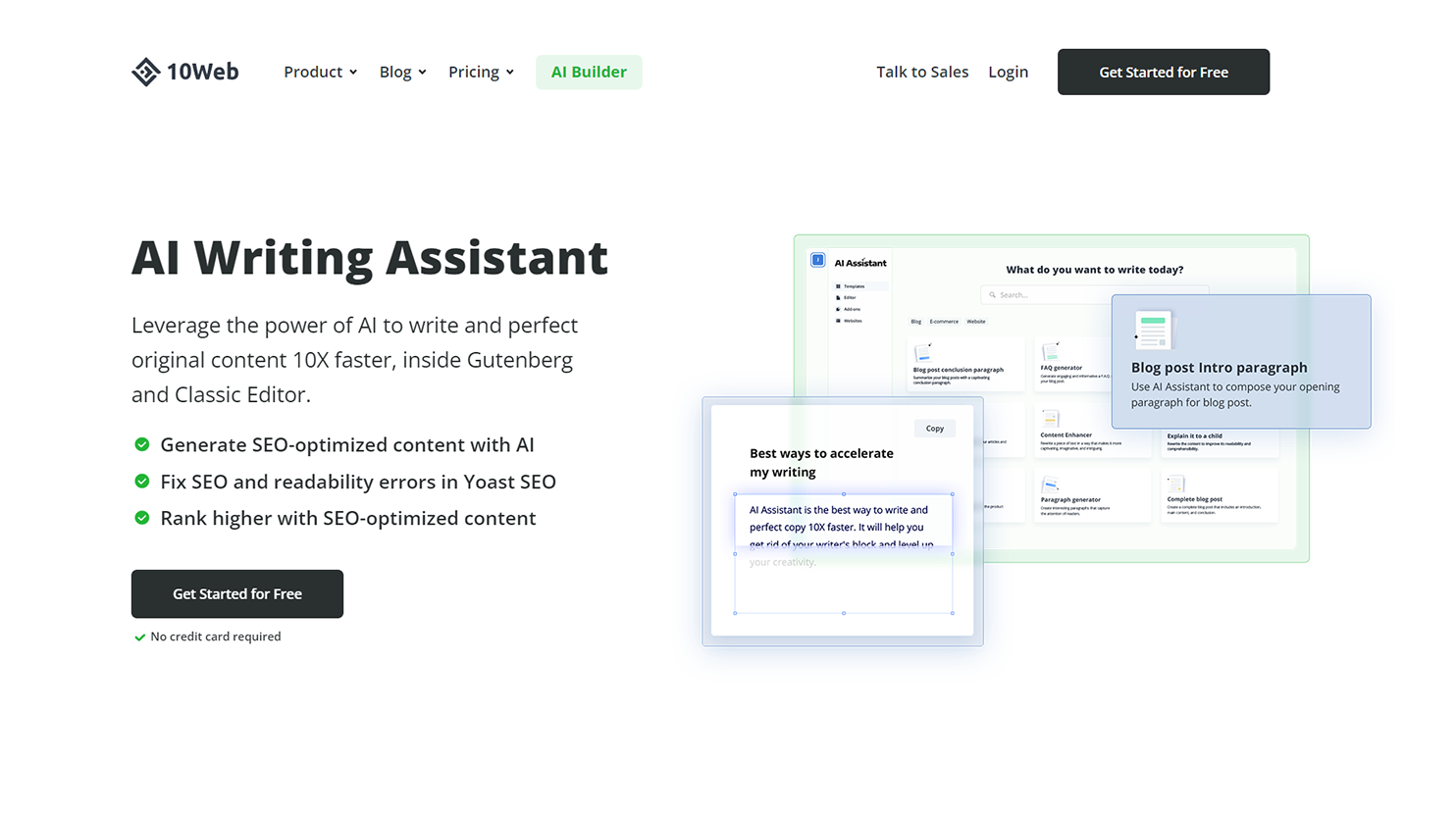
With 10Web AI Writing Assistant for WordPress, you can generate SEO-optimized content with AI 10X faster. It will also let you fix SEO and readability errors directly in Yoast SEO and let your content rank higher on the search engine results page (SERP).
The 10Web AI Writing Assistant can generate content for blog post outlines, intro paragraphs, conclusions, and summaries and let you paraphrase content quickly.
The tool can improve website content by fixing keyphrases and passive voice errors, paragraph and sentence length errors, and subheading distribution errors. It can generate persuasive sales copies and create content for press releases and product descriptions.
Jasper
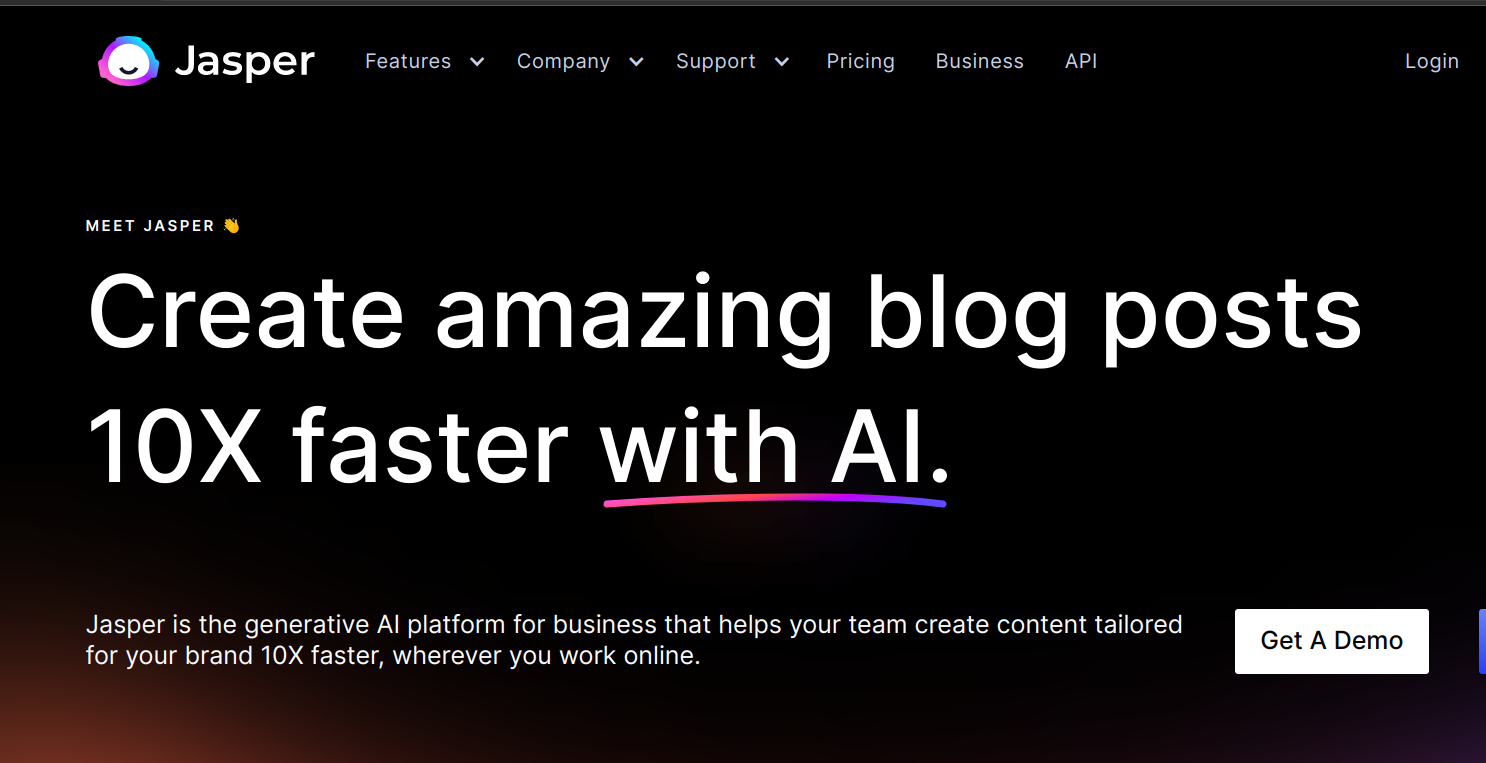
Jasper is another popular content generator that can create tailored content for several domains. You can generate social media posts, emails, website copy, articles, video scripts, etc.
It has a Chrome extension that lets you use templates and write open-ended commands to generate desired content.
Frase
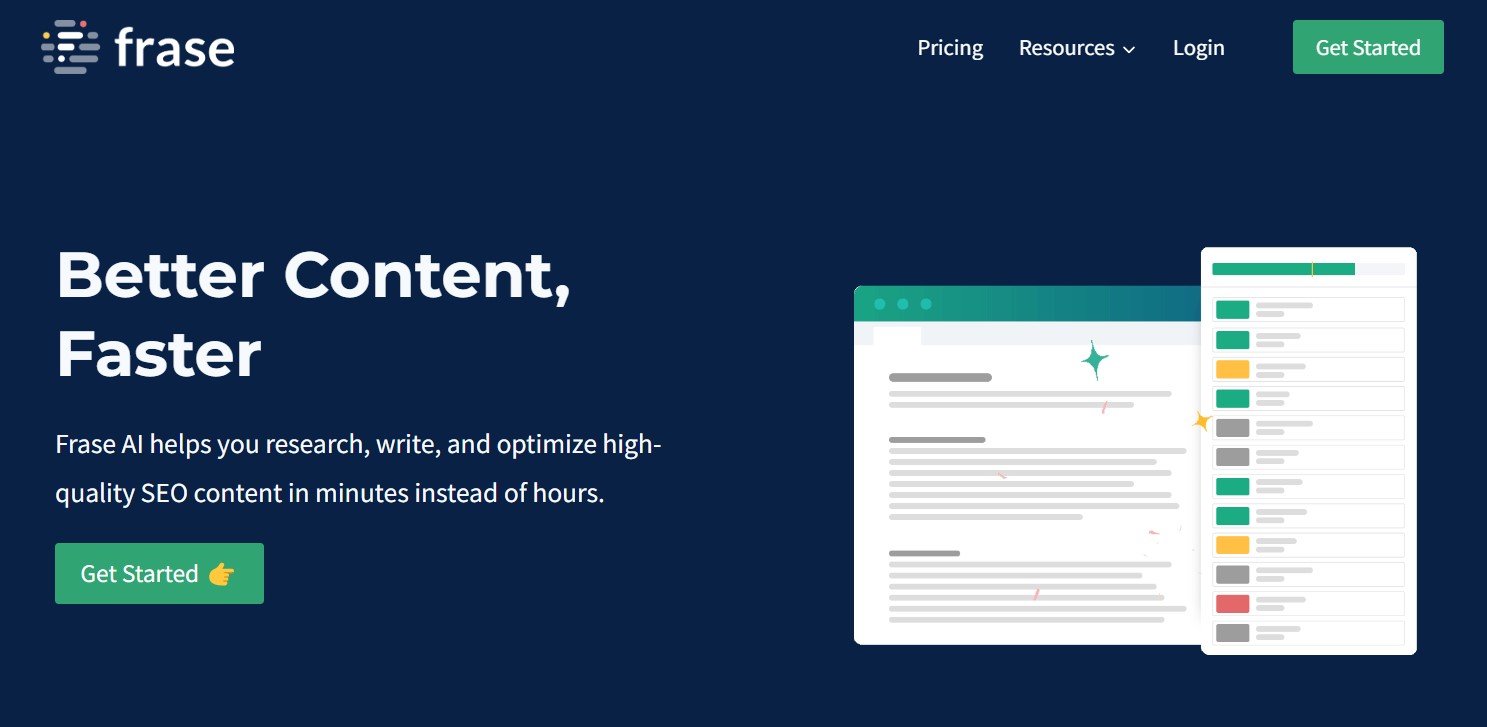
You can use Frase to generate SEO-friendly content and write full-length articles through templates. The tool also helps with keyword research by giving suggestions based on competitors’ content.
Frase integrates with the Google Search Console to give insightful analytics for assessing your content’s performance by measuring click-through rate, rankings, impressions, etc.
Conclusion
How to write website copy is a simple art. The most fundamental rule that you must follow while writing copy is how you can deliver value to your reader. Remember, your visitors are investing their time reading your content – so you must make it worth their time.
You can use AI tools such as 10Web AI Writing Assistant for WordPress to generate SEO-optimized content 10x faster. The assistant will help you fix SEO And readability in errors directly in Yoast SEO – a popular SEO tool – and help you boost rankings.
With 10Web AI Writing Assistant, you can quickly create compelling meta descriptions and titles, fix keyphrase and passive voice errors, improve subheading distribution errors, optimize sentence and paragraph lengths, and paraphrase for more significant impact.
FAQ
What are the best practices for writing headlines that grab attention?
- Write headlines with fewer words. Ideally, it should be six words or less.
- It should include your primary keyword or its variations.
- Be very specific. Your headlines should indicate what a particular section contains. It increases your content’s readability.
Why is storytelling important in website copywriting?
convince the customer to buy. Storytelling helps you achieve this objective. Writing website copy using an engaging storyline can involve sharing a personal story about the product, co-founders, and other relevant team members, telling an actual customer’s journey with your company, and adding an emotional touch.
How to use emotional triggers to connect with your audience?
How to measure the effectiveness of your website copy?
A/B testing is the ideal way to measure if you’re getting the desired results. You can also track metrics like website traffic, the average time a customer spends on your landing page, SEO rankings, etc.
What are some common pitfalls to avoid when writing website copy?
Secondly, proofreading is a task that writers often ignore. Minor grammatical and spelling errors can undermine your business’s credibility.
Lastly, keyword stuffing is a common problem. Copywriters must learn how to write website copy using keywords organically so their content sounds natural and engaging.







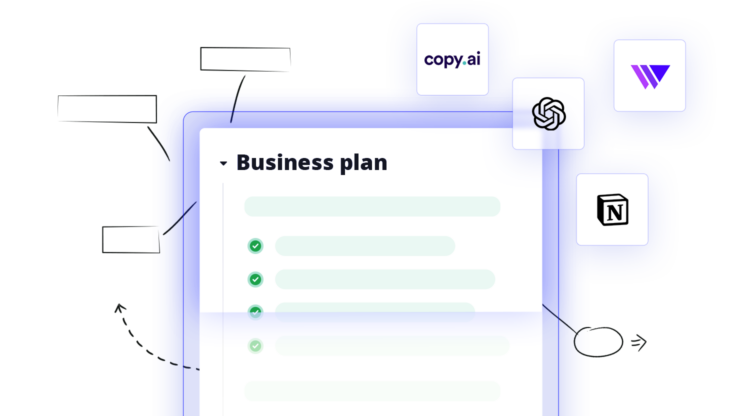




This is really an insightful post. I will really apply some of the strategies in my blog.
Thank you for your feedback!